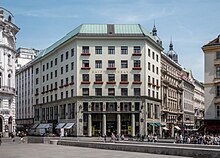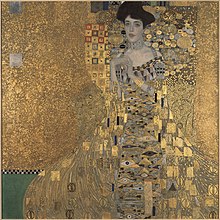Wiener Moderne
This article needs additional citations for verification. (February 2024) |


The Wiener Moderne (German pronunciation: [vinɛʁ mɔˈdɛʁnə]) or Viennese Modernism is a term describing the culture of Vienna in the period between approximately 1890 and 1910. It refers especially to the development of modernism in the Austrian capital and its effect on the spheres of philosophy, literature, music, art, design and architecture.
Background
Under Emperor Franz Joseph I., the conservative-catholic Austrian-Hungarian Empire reaches its zenith and enters its final phase. Industrialization remains comparatively sluggish, a large administrative apparatus continues to tighten its empire-wide grip, with nationality conflicts in the multi-ethnic state coming to a head. Against this backdrop, in the empire's urban centers (Vienna, Budapest, Prague, Trieste, Zagreb, etc.) intellectual achievements abound in the development of - often contradictory - principles, opinions, scientific approaches and trends. The capital city of Vienna, which in 1900 has more than 2 million inhabitants, has become a cultural melting pot, because it is here that Central Europe's economic and intellectual elite congregates.
Viennese political life is complex and tense. Social Democracy (Victor Adler), Zionism (Theodor Herzl) and Austromarxism (Otto Bauer) develop. Vienna's Mayor Karl Lueger, to use his own words, instrumentalizes open anti-Semitism as a political strategy. In 1914, nine percent of Viennese citizens are Jews. Jewish writers, composers, actors and scientists, men such as Karl Kraus, Arthur Schnitzler, Gustav Mahler, Arnold Schoenberg and Alfred Polgar, play important roles in science and the arts.
In an atmosphere characterized by conservative pomp on the one hand, and the pursuit of progress on the other, artists turn their attention away from naturalism and begin to focus on the inner world and on the psyche. The concept of ego disintegration gains traction. Ernst Mach describes the ego as "unrettbar", i.e. beyond recovery. The connection between the ego and society, the "Ich" and the world, is no longer primarily based on reason, but rather on the border regions between dream and reality, reason and feeling. A "mood" is seen as often expressing more than could be conveyed by mere words.
Ideas and concepts are imported via direct personal relationships between individuals who embraced avant-garde thinking. Friedrich Nietzsche and Richard Wagner play an important role in public discourse. The literary critic and author Hermann Bahr regularly commutes between Berlin and Vienna, thus subjecting himself to relentless change as a result of being exposed to ever newer ideas. Bahr stars out as a Wagnerian and a follower of Bismarck, then becomes a Marxist, a naturalist, a symbolist, an expressionist and, finally, a conservative Catholic.
For the implementation of the ideas of Viennese Modernism (as opposed to architectural and literary historicism) the year 1897, with the founding of the Vienna Secession, proved decisive. Adolf Loos, the influential architect, was substantially informed by, and throughout his life remained true to, the impressions he gathered during his stay in America from 1893 to 1896, especially in Chicago and New York.
Characteristics of the Wiener Moderne
This section is empty. You can help by adding to it. (July 2010) |
Significant personalities and works
Philosophy
Ernst Mach was an influential philosopher of science and physicist. Ludwig Wittgenstein made important contributions in analytic philosophy and philosophy of language. Sigmund Freud caused a revolution in psychology through the foundation of psychoanalysis. He published in 1899 (dated 1900) his famous book "The Interpretation of Dreams".
Architecture
The architect
Art
Gustav Klimt is the most notable Viennese artist produced in this period. Characterised by his symbolic use of gold to portray beautifully rendered figures, The Kiss is his most famous piece.
Another significant figure in this movement was Egon Schiele, a pupil of Klimt's. They both pioneered the exploration of sexuality typical of the end of a century.
Literature

The most notable literary grouping of this period was the
Bahr used his position in Vienna as a theatre critic and
The other dominant voice in Viennese literature during this period was the
Music
Wholly characteristic of the Wiener Moderne is the conflict between Gustav Mahler and the Vienna Philharmonic, whose conservative tradition did not align with the modern compositions of Mahler. The fundamental goal of Modernism was to break from the past, but Mahler's attempt to upset tradition was poorly received. Other Modernist musicians in Vienna included Schoenberg, Anton Webern, and Alban Berg, whose compositions were central to the Second Viennese School. Modernist music in Vienna was criticized as nagging, demoralizing, and damagingly hostile, yet the Modernists viewed this as a progressive necessity.[1]
Legacy
This section is empty. You can help by adding to it. (July 2010) |
External references
- Architecture
- Literature
References
- ^ Bradbury, Malcolm and McFarlane, James, Modernism, A Guide to European Literature, 1890-1930, Penguin Books, 1991.
